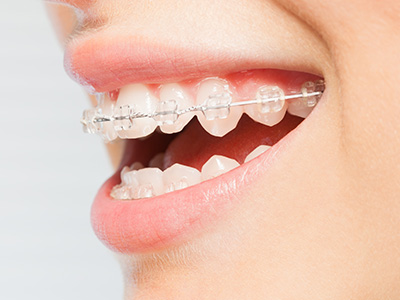South Forsyth County

Our Offices
574 Peachtree Parkway
Suite 110
Cumming, GA 30041
Existing Patients: (770) 886-8911
New Patients: (770) 406-0667
Downtown Cumming

Clear braces—commonly called ceramic braces—offer the familiar control of fixed orthodontic appliances while minimizing the visual footprint of treatment. Instead of metal brackets that stand out against tooth enamel, ceramic brackets are tooth-colored or translucent, allowing them to blend into the smile. These brackets are bonded to the teeth and used with archwires, elastics, and other standard orthodontic components to guide tooth movement predictably over time.
The core biomechanics behind ceramic systems are the same as those used with metal braces: carefully applied, controlled forces move teeth into planned positions. That predictability is one reason clinicians rely on ceramic brackets for many alignment and bite issues. When properly planned and monitored, ceramic braces can address single-arch corrections and full-mouth treatment with an outcome-focused approach that balances esthetics and function.
Choosing a ceramic system is often about priorities—patients who want a lower-profile look without sacrificing the strength of fixed appliances will find ceramic brackets a sensible middle ground. Your orthodontist evaluates tooth movement goals, bite relationships, and oral health factors to determine whether ceramic brackets are the most appropriate option for your individualized treatment plan.
The most immediate appeal of ceramic braces is their appearance. Ceramic materials are designed to mimic natural enamel shades and translucency, which reduces the visual contrast that metal hardware creates. For adults and teens who are image-conscious, ceramic brackets help make the orthodontic process less noticeable while still providing an effective path to a straighter smile.
Comfort is another advantage: many ceramic brackets are contoured and polished to minimize irritation to lips and cheeks. Advances in bracket geometry and bonding techniques have also improved how they sit against tooth surfaces, reducing soft-tissue friction and enhancing day-to-day comfort during treatment. These refinements make long-term wear easier for patients who might otherwise avoid fixed appliances for comfort reasons.
From a clinical standpoint, ceramic brackets integrate with standard orthodontic tools—wires, springs, and elastics—so treatment sequencing remains familiar to skilled clinicians. This compatibility allows orthodontists to leverage tried-and-true mechanics while offering a more subtle aesthetic, ensuring that treatment decisions remain focused on efficient and safe tooth movement.
Ceramic braces are frequently recommended for teens and adults who want the corrective power of fixed appliances but prefer a less conspicuous look. They handle a wide range of tooth movements, including alignment, spacing, and many bite corrections. That said, each case is unique; severe skeletal discrepancies or highly complex movements sometimes require alternative approaches, and your orthodontist will discuss the best strategy for long-term stability and function.
Durability is an important consideration. While modern ceramic brackets are engineered for strength, the material can be more brittle than metal in some situations. Patients are advised to be mindful of certain foods and habits that place heavy stress on brackets and to follow care instructions designed to minimize the risk of bracket fracture or bond failure. When bracket integrity is preserved, treatment proceeds with fewer interruptions and more predictable timing.
Another clinical factor is how ceramic brackets interact with archwires. Some systems are designed to reduce friction between bracket and wire to promote efficient tooth movement, while other configurations require specific wire sequences or additional auxiliaries. Your clinician will explain the chosen appliance protocol and how it supports the intended tooth movements so you understand each step of the plan.
Good oral hygiene is especially important with ceramic braces. Brushing thoroughly after meals, using interdental brushes where recommended, and flossing carefully around brackets remove plaque and food particles that can accumulate at the bracket margin. Consistent hygiene not only helps preserve the esthetic quality of ceramic materials but also protects gum tissue and enamel health throughout treatment.
Dietary adjustments reduce the risk of damage. Hard, crunchy, or very sticky foods can stress or dislodge brackets, so choosing softer alternatives or cutting food into smaller pieces helps protect appliances. Simple behavioral changes—no chewing on ice, pens, or fingernails—also make a measurable difference in preventing unexpected repairs and keeping the treatment schedule steady.
To manage staining around brackets, follow guidance about pigmented beverages and smoking. While modern ceramics resist intrinsic discoloration better than earlier materials, the bond and surrounding tooth can stain if plaque control lapses or if frequent exposure to strong pigments occurs. Regular professional check-ins allow your orthodontic team to address minor staining and keep the overall appearance polished during active treatment.
If a bracket loosens or an elastomeric breaks between visits, prompt communication with your orthodontic office helps avoid treatment setbacks. The team can advise temporary measures and schedule a timely repair so that tooth movement continues as planned with minimal disruption.
Treatment with ceramic braces begins with a comprehensive evaluation and a personalized plan. Records—photographs, X-rays, and digital scans or impressions—help the orthodontist map tooth positions and design an efficient sequence of movements. The initial visit typically includes bracket placement and the first archwire; patients often experience mild pressure for a few days as teeth begin to respond.
Follow-up visits are scheduled at regular intervals—commonly every four to eight weeks—so the clinician can change wires, adjust forces, and monitor progress. These appointments are also opportunities to review oral-care techniques and address questions about comfort or appliance management. Most patients adapt within a week or two and report that daily life quickly returns to routine with a few easy care habits in place.
Near the end of active movement, the orthodontist focuses on fine-tuning alignment and bite relationships to achieve a stable, functional outcome. Once active treatment goals are met, the retention phase begins. Retainers—customized and discussed well before appliance removal—are essential to maintaining the new tooth positions and protecting the investment of treatment time.
Ceramic braces provide a balance of dependable tooth movement and a low-profile appearance for many patients seeking orthodontic care. If you’d like to explore whether ceramic brackets are a good fit for your needs, contact Inspirational Smiles Orthodontics to learn more or to arrange a consultation. Our team can answer your questions and help you consider the best path forward for a confident, healthy smile.
Ceramic braces are tooth-colored or translucent brackets bonded to teeth, working with archwires and elastics to move teeth predictably. They function like traditional metal braces but are designed to be more discreet.
Teens and adults who want the corrective power of fixed appliances but prefer a less noticeable look are ideal candidates. They can address alignment, spacing, and many bite corrections, though highly complex cases may require alternative approaches.
Many ceramic brackets are contoured and polished to minimize irritation to lips and cheeks. Advances in bracket geometry and bonding have reduced soft-tissue friction, making long-term wear more comfortable compared to older systems.
Modern ceramic brackets are strong but can be more brittle than metal. Patients should avoid hard, sticky, or very chewy foods and follow care instructions to prevent fractures or bond failure.
Maintain good oral hygiene by brushing thoroughly after meals, using interdental brushes, and flossing carefully. Avoid habits that can damage brackets and limit exposure to pigmented foods and drinks to reduce staining around brackets.
Treatment starts with a comprehensive evaluation and personalized plan, followed by bracket placement and the first archwire. Regular follow-up visits every 4–8 weeks allow wire adjustments and progress monitoring. Most patients adapt within a week or two to daily routines.
Once active treatment goals are met, the retention phase begins. Retainers, customized to each patient, help maintain new tooth positions and protect the results achieved during treatment.



No referral is needed; your first visit includes a complimentary consultation to see how orthodontic treatment may help you. We invite you to be our special guest.
